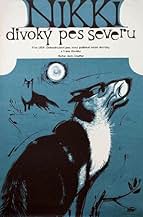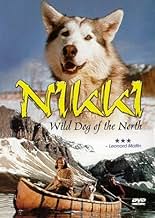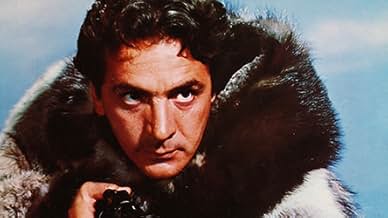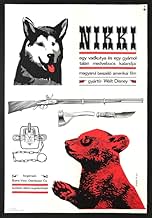AVALIAÇÃO DA IMDb
6,6/10
544
SUA AVALIAÇÃO
Adicionar um enredo no seu idiomaThe rugged Canadian wilderness is the backdrop to this story of a dog separated from his owner.The rugged Canadian wilderness is the backdrop to this story of a dog separated from his owner.The rugged Canadian wilderness is the backdrop to this story of a dog separated from his owner.
- Direção
- Roteiristas
- Artistas
- Prêmios
- 1 vitória no total
Avaliações em destaque
10Figaro-8
One thing can be said about Disney in the 50s and 60s, and that is it put out some great films with animal stars, from the True-Life Adventure series to "Old Yeller" and others. This film combines a True-Life filmmaking approach with a good adventure story, and the result is entertaining family fare. The Malamute and the bear cub are adorable! Both adventure and nature commentary are shown, combined with gorgeous on-location photography (filmed in Canada) and a nice music score.
"Nikki, Wild Dog of the North" was an interesting hybrid of a movie made while Walt Disney was still alive, though not the first time Disney made such a hybrid. It is a cross between one of Disney's True Life documentaries with a fictional narrative. The end results are somewhat mixed. There is some nice scenery, a breezy narrative, and the footage of animals in action is interesting - especially since some of the stuff the animals are put through would probably cause an outcry by the SPCA and animal lovers today. The human side of the movie is somewhat less successful, with human characters that are stereotyped at best and downright goofy at their worst. The narration is overbearing and pretentious at times as well. All of this results in a movie that is probably best for younger children, though older children and their parents will probably find it bearable if they can't find anything better to watch.
One thing that stands out in this film is the beautiful Canadian scenery. The river - so blue! Then you add mountains, trees, and when it snows - its just stunning beauty. A cute little story as well, though not Disney's best, that centers on the adventures of a dog that loses his owner. If you liked this, you may want to check out Ten Who Dared which I found a little more entertaining adventure (about men traversing the Colorado - although all brown!). I also preferred Disney's White Wilderness as a little better overall. While not a gripping story, it is entertaining enough and is the kind of movie families should watch more of these days.
'Nikki, Wild Dog of the North" is a live action animal film typical of the Disney studios in the sixties. Its stars are a dog that is part wolf (Nikki) and a bear, who grow up together. This is a story that feels like a Jack London tale, full of adventure and celebrating the natural world.
The filmmakers impose their story on some real action sequences and, probably, also stage their animal "stars" to conform to the desired story. A voice over is used to pull the parts of the story together and to provide human interpretations of animal behaviors. This anthropomorphism, while a large part of what makes the film enjoyable for some, trades in common misconceptions of animals and furthers inaccurate beliefs about animal psychology. When the narrator says the dog feels certain emotions or make judgments based upon rational decisions, it obscures the real nature of the animal.
While children will find much of the story adorable and engaging, they should be disabused of the conceit that the animals have thought processes like humans. Besides, it is not necessary for dogs to think and feel like humans for them to be good companions.
While the interactions between some of the animals usually can be explained by the filmmakers imposing their story on natural behavior, one has to wonder about the scenes involving the dog and a wolverine or the dog and some rats. Were any animals harmed in the making of this film or were animals put in harm's way?
In the end, there are some incredibly beautiful scenes of nature, including towering mountains and lovely blue waters in all seasons. And the values inherent in this film are kindness and respect for life.
The filmmakers impose their story on some real action sequences and, probably, also stage their animal "stars" to conform to the desired story. A voice over is used to pull the parts of the story together and to provide human interpretations of animal behaviors. This anthropomorphism, while a large part of what makes the film enjoyable for some, trades in common misconceptions of animals and furthers inaccurate beliefs about animal psychology. When the narrator says the dog feels certain emotions or make judgments based upon rational decisions, it obscures the real nature of the animal.
While children will find much of the story adorable and engaging, they should be disabused of the conceit that the animals have thought processes like humans. Besides, it is not necessary for dogs to think and feel like humans for them to be good companions.
While the interactions between some of the animals usually can be explained by the filmmakers imposing their story on natural behavior, one has to wonder about the scenes involving the dog and a wolverine or the dog and some rats. Were any animals harmed in the making of this film or were animals put in harm's way?
In the end, there are some incredibly beautiful scenes of nature, including towering mountains and lovely blue waters in all seasons. And the values inherent in this film are kindness and respect for life.
Nikki is a malamute / wolf hybrid (the narration informs us that he's 1/8th wolf) who's the devoted companion to late 19th century French-Canadian trapper Andre Dupas (Jean Coutu). One day, after they've acquired a black bear cub as a third member of the group, their canoe capsizes in some rapids, and the man and the animals are separated. The bulk of the tale details what happens as Nikki and the cub (dubbed Neewa) form a friendship and survive in the wilderness together.
The novel "Nomads of the North" by James Oliver Curwood (whose writings were also the basis for the 1989 film "The Bear") seems ideal fare for the Disney company, if perhaps a little intense and violent at times for the youngest of children. But there is still very little blood, and there are a steady parade of engaging animal characters (including a mean-tempered grizzly) to keep younger viewers enchanted. Ultimately, the film is one of those appealing tales that either enriches our appreciation for nature, or helps to develops it. The scenery (this was actually filmed in the Canadian wilderness) is as beautiful as one would expect it to be, and the pacing & storytelling pretty succinct. (This only runs an hour and 14 minutes). The final portions, with Nikki forced into a brief bout of dog-fighting, will be uncomfortable for members of the audience.
This does come off as a little cheesy and precious at times (with amusing, genial narration spoken by Jacques Fauteux), so it likely won't be to all tastes, but the animal action is top-notch. The animals are actually more engaging than the human characters, who aren't really fleshed out. All you need to know about trapper Jacques Lebeau (Emile Genest) is that he's a very bad man. Uriel Luft plays Lebeaus' Indian companion Makoki, a much more kind-hearted individual. Nikki himself is simply adorable.
Written by Ralph Wright & producer Winston Hibler, and directed by Jack Couffer (also one of the cinematographers) and Don Haldane. Since the cast members were French-Canadian, they did the dubbing for the French-language version.
Seven out of 10.
The novel "Nomads of the North" by James Oliver Curwood (whose writings were also the basis for the 1989 film "The Bear") seems ideal fare for the Disney company, if perhaps a little intense and violent at times for the youngest of children. But there is still very little blood, and there are a steady parade of engaging animal characters (including a mean-tempered grizzly) to keep younger viewers enchanted. Ultimately, the film is one of those appealing tales that either enriches our appreciation for nature, or helps to develops it. The scenery (this was actually filmed in the Canadian wilderness) is as beautiful as one would expect it to be, and the pacing & storytelling pretty succinct. (This only runs an hour and 14 minutes). The final portions, with Nikki forced into a brief bout of dog-fighting, will be uncomfortable for members of the audience.
This does come off as a little cheesy and precious at times (with amusing, genial narration spoken by Jacques Fauteux), so it likely won't be to all tastes, but the animal action is top-notch. The animals are actually more engaging than the human characters, who aren't really fleshed out. All you need to know about trapper Jacques Lebeau (Emile Genest) is that he's a very bad man. Uriel Luft plays Lebeaus' Indian companion Makoki, a much more kind-hearted individual. Nikki himself is simply adorable.
Written by Ralph Wright & producer Winston Hibler, and directed by Jack Couffer (also one of the cinematographers) and Don Haldane. Since the cast members were French-Canadian, they did the dubbing for the French-language version.
Seven out of 10.
Você sabia?
- CuriosidadesAll French-Canadian actors did dub themselves in the French version. No explanation if it was done either in Disney studios in Los Angeles, in Montreal's "Syncro-Québec" studio or SPS studio in Paris, France.
- ConexõesEdited into Disneylândia: Nikki, Wild Dog of the North: Part 1 (1964)
Principais escolhas
Faça login para avaliar e ver a lista de recomendações personalizadas
- How long is Nikki, Wild Dog of the North?Fornecido pela Alexa
Detalhes
- Data de lançamento
- Países de origem
- Central de atendimento oficial
- Idioma
- Também conhecido como
- Nikki, Wild Dog of the North
- Locações de filme
- Kananaskis Country, Alberta, Canadá(exterior scenes)
- Empresas de produção
- Consulte mais créditos da empresa na IMDbPro
- Tempo de duração
- 1 h 14 min(74 min)
- Proporção
- 1.33 : 1
Contribua para esta página
Sugerir uma alteração ou adicionar conteúdo ausente






















